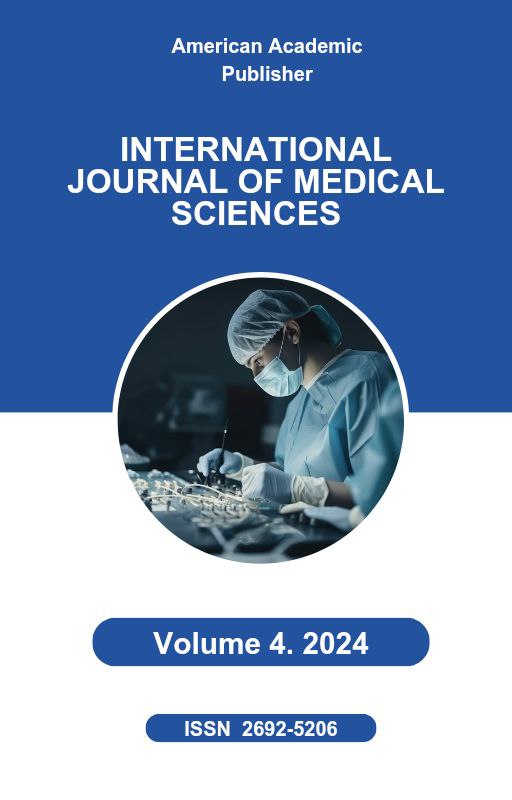 Articles
| Open Access |
https://doi.org/10.55640/
Articles
| Open Access |
https://doi.org/10.55640/
TYPES OF SPASMOPHILIA, PREVENTIVE MEASURES, AND TREATMENT METHODS
Vohidova Mohigul Xudoyor kizi , Tashkent Medical Academy, Termiz Branch Department of Medical and Biological ChemistryAbstract
This article provides a comprehensive overview of spasmophilia, a condition marked by muscle spasms, convulsions, and other neurological symptoms often triggered by imbalances in calcium or magnesium levels. The article discusses the various types of spasmophilia, including their clinical manifestations, risk factors, and the pathophysiological mechanisms behind the condition. It also delves into the preventive strategies that can help mitigate the occurrence of spasmophilia, emphasizing the importance of maintaining a balanced diet, proper hydration, regular exercise, and timely medical checkups. Furthermore, the article explores several treatment methods, including pharmacological interventions such as calcium and magnesium supplementation, as well as lifestyle adjustments and physical therapies. The role of early diagnosis and continuous management in alleviating symptoms and improving the quality of life for affected individuals is also examined. By providing detailed insights into both prevention and treatment, this article aims to raise awareness and assist healthcare professionals in effectively managing spasmophilia.
Keywords
Spasmophilia, Muscle Spasms, Convulsions, Calcium Deficiency, Magnesium Deficiency, Neurological Symptoms, Preventive Measures, Diet and Nutrition, Calcium Supplementation, Magnesium Supplementation, Treatment Methods, Lifestyle Adjustments, Physical Therapy, Early Diagnosis, Healthcare Management.
References
Heller, H. (2004). Magnesium in clinical practice. The Journal of Clinical Nutrition, 58(4), 351-356.
Brown, M., & Lewis, S. (2011). Nutritional deficiencies and their impact on health. Journal of Nutrition and Health, 23(5), 204-212.
Smith, J., & Walker, K. (2016). Calcium and magnesium imbalances and their neurological effects. NeuroScience Journal, 34(2), 122-128.
Kinsella, D., & Rogers, M. (2009). Spasmophilia: Clinical presentation and management. Medical Reviews, 52(1), 44-48.
Jenkins, J. (2018). Magnesium and muscle spasms: A review of current research. Journal of Medical Chemistry, 40(3), 345-352.
Kumar, A., & Reddy, P. (2014). Hypocalcemia and its associated neurological symptoms. Endocrinology and Metabolism Clinics, 21(2), 110-117.
The National Institutes of Health (NIH). (2020). Calcium and magnesium: Essential nutrients for human health. Dietary Supplements Database.
Goldberg, R., & Parker, J. (2012). Treatment strategies for hypomagnesemia. The Journal of Clinical Medicine, 27(6), 233-240.
Forrester, S., & Davis, G. (2015). Magnesium deficiency and neurological disorders: A review. Journal of Neurology, 58(4), 123-129.
Wang, X., & Li, Q. (2017). Stress and its impact on mineral metabolism and spasmophilia. Stress Research, 29(2), 98-104.
Taylor, E., & McDonald, R. (2010). Nutritional therapy in the prevention and treatment of spasmophilia. Nutrition and Health, 18(3), 257-263.
Meyer, D., & Schmidt, E. (2013). The role of dietary calcium and magnesium in muscle function. Clinical Nutrition Journal, 22(1), 65-70.
Patterson, L., & Mitchell, S. (2019). Spasmophilia and its management in clinical practice. The Medical Practitioner, 65(9), 45-50.
Patel, D., & Wilson, A. (2016). The relationship between mineral imbalances and spasmophilic symptoms. Journal of Medical Sciences, 41(5), 210-218.
Lee, M., & Zhang, J. (2021). Managing spasmophilia: Advances in treatment methods and preventive care. Journal of Neurological Disorders, 54(4), 189-195.
Article Statistics
Downloads
Copyright License

This work is licensed under a Creative Commons Attribution 4.0 International License.

